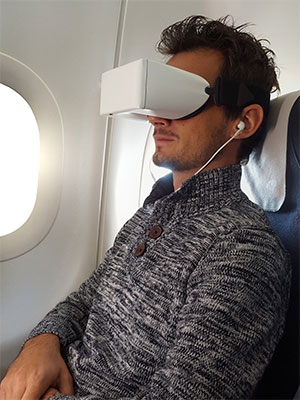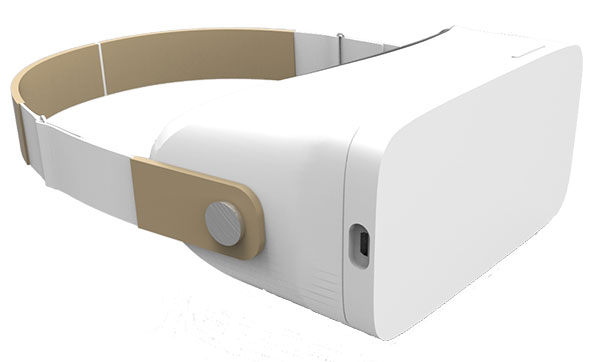
Following last week’s announcement that charter airline XL Airways France has become the first carrier to trial the SkyTheater immersive cinema headset, FTE can reveal that four major airlines based in Europe and the Middle East have also agreed to trial the pioneering in-flight entertainment (IFE) solution on board their aircraft.
The wearable technology headset offers an immersive movie experience in both 2D and 3D. It is not a virtual reality headset, as it provides a fixed-screen, cinema/movie theatre-like viewing experience, which doesn’t require the user to move their head around. Instead, users feel like they are watching a movie on a large cinema screen. David Dicko, CEO of Skylights, the company behind SkyTheater, said: “Our mission is to bring the movie theatre or cinema experience on board using immersive glasses.” He added: “It will give the passenger the sense that they’re no longer where they are, which is on board an aircraft.”
While the SkyTheater headset has been trialled in an airline lounge in the past, the recently announced trial with XL Airways France marks the first use of the solution in-flight. Eight headsets have been trialled in the first phase and up to 35 will be available during the second phase. “The first testing phase and the results have been very good with a 99% satisfaction rating,” Dicko stated. Referring to the upcoming trials with four more carriers (the names of which can not yet be revealed by FTE due to non-disclosure agreements), he said Skylights hopes to start with 30-40 devices on each flight.
‘SkyTheater addresses in-flight constraints’
Dicko explained to FTE that SkyTheater has been specifically developed for in-flight use, unlike consumer virtual reality products (which have been trialled by the likes of Qantas and Transavia) that have been developed with home use in mind. This, he said, means the solution addresses the “multiple constraints on board”. “The virtual reality cinema experience requires the user to move their head and look around. This is because VR offers a 110-degree viewing angle, which is far from ideal to watch a movie. As far as the freedom of movement side of VR, it is heavily constrained on board, especially in economy,” Dicko explained.
“People are stuck in their seat with limited ability to move. They’re stuck there for hours. Our solution is completely autonomous and the passenger can wear it comfortably for a long time. It takes into consideration the huge spatial constraints on board. The SkyTheater can completely isolate you from the rest of the cabin, so we would call it an immersive cinema headset.”
A competitor to seatback IFE?

The current version of SkyTheater offers 128GB of storage, which Dicko said equates to around 40 HD movies, but the next version will also allow for content to be streamed to the headset. Moreover, he revealed Skylights is talking to the Hollywood studios to explore the possibility of offering Early Window Content on the devices, which should be feasible given the devices will be owned by the airlines, not the passengers.
Despite the interest from major airlines, Dicko said Skylights’ plan is not to eat into the market share of the seatback IFE suppliers. “We don’t see ourselves as being an immediate competitor to seatback screens. We complement them,” he stated. “We have airlines wanting to use them to “premium up” their first or business class product, and we have others who want to rent them to passengers to make additional ancillary revenue.”
Either way, the SkyTheater certainly seems to have caught the eye of multiple airlines already, adding weight to the theory that the next generation of in-flight entertainment is well and truly upon us.






